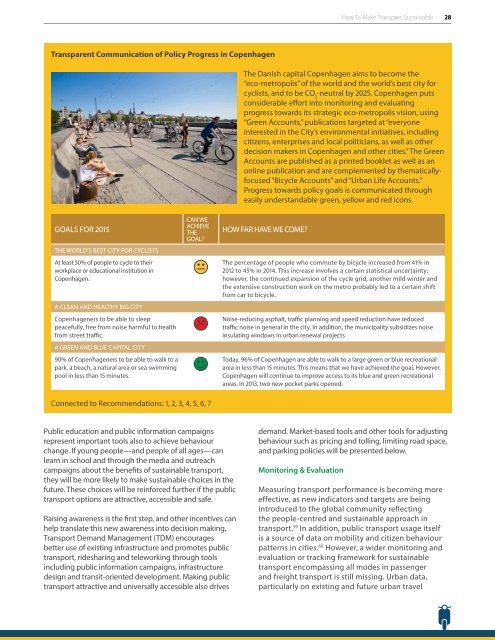MOBILIZING DEVELOPMENT
a5OQ306q56U
a5OQ306q56U
You also want an ePaper? Increase the reach of your titles
YUMPU automatically turns print PDFs into web optimized ePapers that Google loves.
How To Make Transport Sustainable 28<br />
Transparent Communication of Policy Progress in Copenhagen<br />
The Danish capital Copenhagen aims to become the<br />
“eco-metropolis” of the world and the world’s best city for<br />
cyclists, and to be CO 2<br />
-neutral by 2025. Copenhagen puts<br />
considerable effort into monitoring and evaluating<br />
progress towards its strategic eco-metropolis vision, using<br />
“Green Accounts,” publications targeted at “everyone<br />
interested in the City’s environmental initiatives, including<br />
citizens, enterprises and local politicians, as well as other<br />
decision makers in Copenhagen and other cities.” The Green<br />
Accounts are published as a printed booklet as well as an<br />
online publication and are complemented by thematicallyfocused<br />
“Bicycle Accounts” and “Urban Life Accounts.”<br />
Progress towards policy goals is communicated through<br />
easily understandable green, yellow and red icons.<br />
GOALS FOR 2015<br />
THE WORLD’S BEST CITY FOR CYCLISTS<br />
At least 50% of people to cycle to their<br />
workplace or educational institution in<br />
Copenhagen.<br />
A CLEAN AND HEALTHY BIG CITY<br />
Copenhageners to be able to sleep<br />
peacefully, free from noise harmful to health<br />
from street traffic.<br />
A GREEN AND BLUE CAPITAL CITY<br />
90% of Copenhageners to be able to walk to a<br />
park, a beach, a natural area or sea swimming<br />
pool in less than 15 minutes.<br />
CAN WE<br />
ACHIEVE<br />
THE<br />
GOAL?<br />
HOW FAR HAVE WE COME?<br />
The percentage of people who commute by bicycle increased from 41% in<br />
2012 to 45% in 2014. This increase involves a certain statistical uncertainty;<br />
however, the continued expansion of the cycle grid, another mild winter and<br />
the extensive construction work on the metro probably led to a certain shift<br />
from car to bicycle.<br />
Noise-reducing asphalt, traffic planning and speed reduction have reduced<br />
traffic noise in general in the city. In addition, the municipality subsidizes noise<br />
insulating windows in urban renewal projects<br />
Today, 96% of Copenhagen are able to walk to a large green or blue recreational<br />
area in less than 15 minutes. This means that we have achieved the goal. However,<br />
Copenhagen will continue to improve access to its blue and green recreational<br />
areas. In 2013, two new pocket parks opened.<br />
Connected to Recommendations: 1, 2, 3, 4, 5, 6, 7<br />
Public education and public information campaigns<br />
represent important tools also to achieve behaviour<br />
change. If young people—and people of all ages—can<br />
learn in school and through the media and outreach<br />
campaigns about the benefits of sustainable transport,<br />
they will be more likely to make sustainable choices in the<br />
future. These choices will be reinforced further if the public<br />
transport options are attractive, accessible and safe.<br />
Raising awareness is the first step, and other incentives can<br />
help translate this new awareness into decision making.<br />
Transport Demand Management (TDM) encourages<br />
better use of existing infrastructure and promotes public<br />
transport, ridesharing and teleworking through tools<br />
including public information campaigns, infrastructure<br />
design and transit-oriented development. Making public<br />
transport attractive and universally accessible also drives<br />
demand. Market-based tools and other tools for adjusting<br />
behaviour such as pricing and tolling, limiting road space,<br />
and parking policies will be presented below.<br />
Monitoring & Evaluation<br />
Measuring transport performance is becoming more<br />
effective, as new indicators and targets are being<br />
introduced to the global community reflecting<br />
the people-centred and sustainable approach in<br />
transport. 59 In addition, public transport usage itself<br />
is a source of data on mobility and citizen behaviour<br />
patterns in cities. 60 However, a wider monitoring and<br />
evaluation or tracking framework for sustainable<br />
transport encompassing all modes in passenger<br />
and freight transport is still missing. Urban data,<br />
particularly on existing and future urban travel


